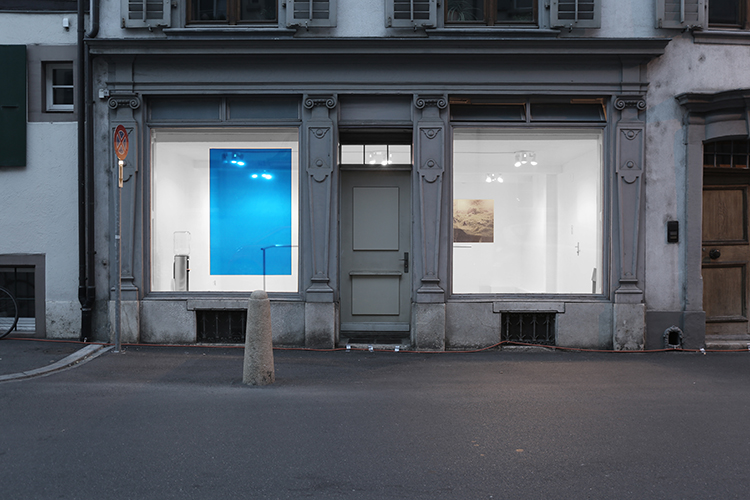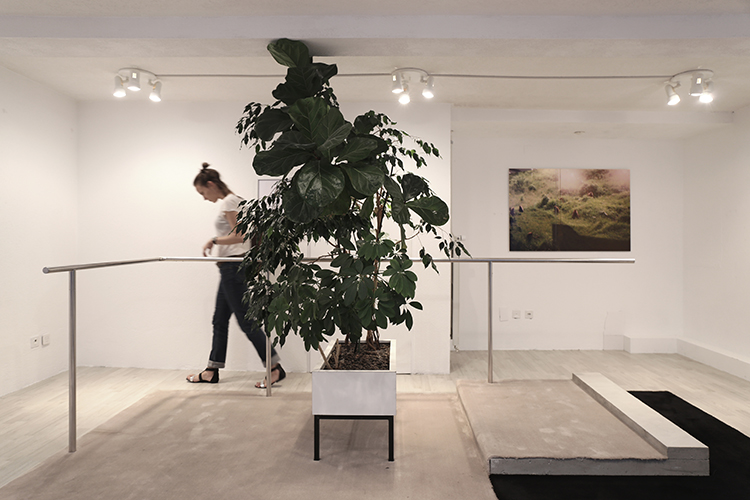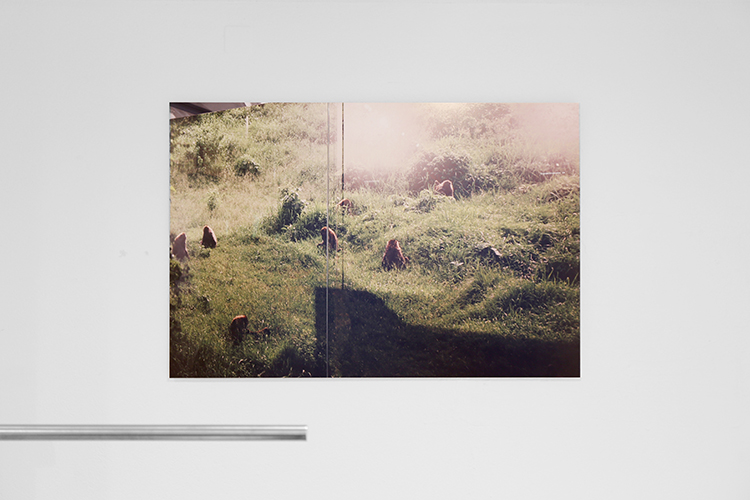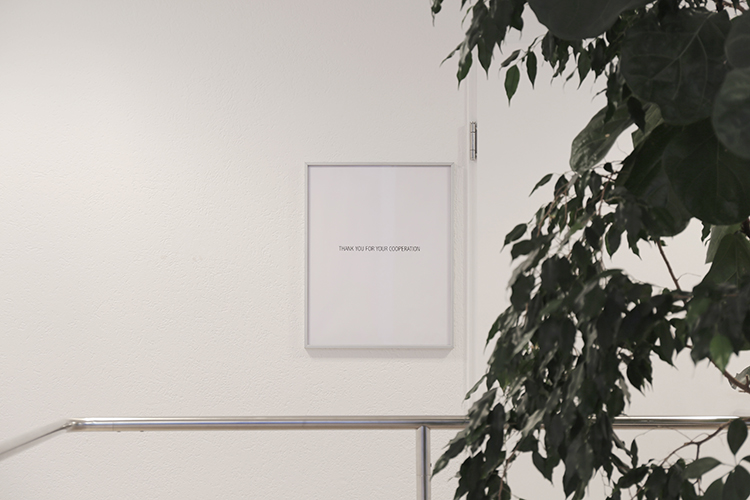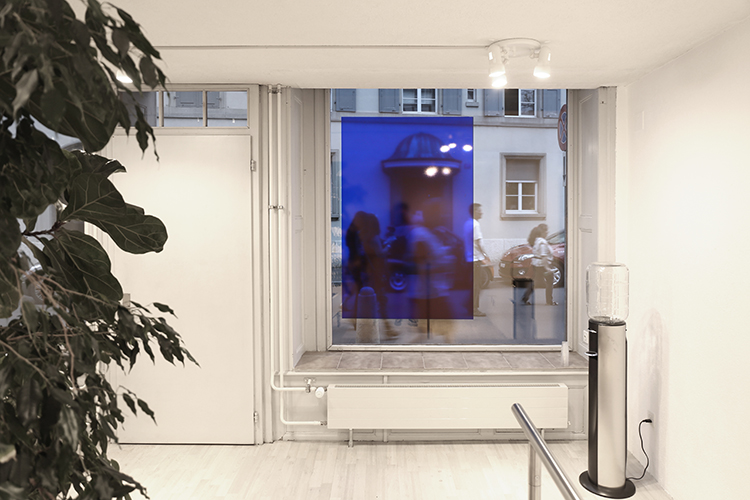Reliance Room
[…] Contemporary man. His life is full of miracles – miracles that not only surpass the wonders of technology, but make fun of them. […] Nature and technology, primitiveness and comfort, have completely merged. And to people who have grown weary of the endless complications of everyday living and to whom the purpose of existence seems to have been reduced to the most distant vanishing point on an endless horizon, it must come as a tremendous relief to find a way of life in which everything is solved in the simplest and most comfortable way, in which a car is no heavier than a straw hat and the fruit on the tree becomes round as quickly as a hot-air baloon. And now we need to step back and keep our distance.i
- Walter Benjamin, Experience and Poverty, 1933
Was it the beautiful image that has brought you here? A picture of leaves and flowers in a flowerbed, tinted in a melancholic (or even nostalgic), saturised blue with a slight tinge of red, and the words written in white in a somewhat conservative, classic font. What do you expect? The information provided has given you what you needed and now you are here.
Sylvain Baumann's site-specific intervention Reliance Room at utengasse sechzig has been conceived by the artist as both a physical, immersive experience as well as a kind of scenography. To that end, the artist makes use of the most prominent architectural feature of the former shop, the two large shop windows, which draw the attention of the people passing by. The installation may thus be perceived upon entering the space, but people may also look at it from the outside. Using a thoroughly chosen set of requisites – objects familiar and generic to us – Baumann has transformed the space making reference to places we frequently encounter, dwell and spend time in, but barely pay attention to: lobbies, reception areas, corridors, and passage ways – places usually characterised by a lack of personal marks and traces.
Reliance Room makes reference to these generic, anonymous places, where we pass through or wait, offering to us a form of comfort – as the title indicates – through their familiarity, while allowing for us to explore the nature of these places of transition. Devoid of any specificity and personality these places by contrast (by denying us any form of relation or potential for experience) become full of our expectations. This play with our anticipation and desire through a specific choreography lined out in the space in Reliance Room is furthermore turned into a game of hide and seek: Half-concealed behind plotted plants that attract our view and may remind us of the image from the invitation, there is a framed object mounted on the wall. Driven by curiosity we get closer, thereby trespassing the physical barriers installed to control and direct our movements, and at the same time to enhance our expectations.
Sylvain Baumann's intervention at utengasse sechzig confronts us with a conundrum drawing our attention to the intentions informing the shape of the places we encounter in our daily life. Modern architecture has provided us with impoverished, 'purified', primitive, physical surroundings. By contrast the virtual world of the Internet bears an incommensurable overload of fugitive information and visual stimuli.While identities and in fact our lives have taken on a second (and not necessarily secondary) presence on the Internet, so have those of institutions and cooperations. Reliance Room allows for questions around the relationships between the virtual representations, the physical realm of our experience, and our mental images and expectations. Reliance Room thus also focuses on the question about our expectations and projections and about who or what informs our actions. Finally Reliance Room allows us to engage with the subject of attention itself; attentionii understood as the means by which the individual visitor can transcend subjective limitations and make perception their own, and attention also understood as a means by which a visitor becomes open to control and annexation by an external agency.
Text: Mareike Spendel
|
|
Reliance Room
[...] Traum der heutigen Menschen. Dieses Dasein ist voller Wunder, die nicht nur die technischen überbieten, sondern sich über sie lustig machen. […] Natur und Technik, Primitivität und Komfort sind hier vollkommen eins geworden und vor den Augen der Leute, die an den endlosen Komplikationen des Alltags müde geworden sind und denen der Zweck des Lebens nur als fernster Fluchtpunkt in einer unendlichen Perspektive von Mitteln auftaucht, erscheint erlösend ein Dasein, das in jeder Wendung auf die einfachste und zugleich komfortabelste Art sich selbst genügt, in dem ein Auto nicht schwerer wiegt als ein Strohhut und die Frucht am Baum so schnell sich rundet wie die Gondel eines Luftballons. Und nun wollen wir einmal Abstand halten, zurücktreten.i
Walter Benjamin – Erfahrung und Armut, 1933
War es das schöne Bild, das dich hergeführt hat? Ein Bild von Blättern und Blüten in einem Blumenbeet, getönt in ein melancholisches (oder sogar nostalgisches), tiefes Blau mit einem leichten Rotstich, dazu die Wörter geschrieben in Weiß in einem konservativen, klassischen Font. Was erwartest du? Die mitgelieferten Informationen gaben dir, was du brauchtest und jetzt bist du hier.
Sylvain Baumanns ortsspezifische Intervention Reliance Room in der utengasse 60 wurde vom Künstler sowohl als physisch, immersiver Erfahrungsraum als auch als eine Art Szenographie konzipiert. Dafür macht der Künstler Gebrauch von einem der hervorstechendsten architektonischen Merkmale des ehemaligen Ladengeschäfts, den beiden großen Schaufenstern, die die Aufmerksamkeit der Passanten auf sich ziehen. So ist die Installation sowohl durch das Betreten des Raumes wahrnehmbar, kann jedoch auch von aussen betrachtet werden. Unter Verwendung einer Reihe sorgfältig ausgewählter Requisiten – allgemein gebräuchliche und uns vertraute Gegenstände – hat der Künstler den Raum verwandelt und verweist dabei auf Orte, wir wir sie häufig antreffen, in denen wir uns aufhalten und Zeit verbringen, aber denen wir selten Aufmerksamkeit schenken: Lobbies, Empfangsbereiche, Korridore, Durchgänge – Räume, die sich gewöhnlich durch das Fehlen von persönlichen Zeichen und Spuren auszeichnen.
Reliance Room nimmt Bezug auf diese alltäglichen und anonymen Orte, die wir durchqueren, oder in denen wir warten, bietet uns dabei – wie der Titel andeutet – eine Art Sicherheit durch ihre Vertrautheit, und erlaubt uns die Eigenarten dieser Orte des Übergangs zu erkunden. Durch das Fehlen jeglicher Spezifik oder Persönlichkeit füllen sich diese Räume im Gegenzug (indem sie uns jede Form der Bezugnahme oder Möglichkeit der Erfahrung verwehren) mit unseren Erwartungen. Dieses Spiel mit unseren Vorstellungen und unserer Sehnsucht wird in Reliance Room darüber hinaus zum Versteckspiel durch eine spezifische, im Raum angelegte Choreographie: Halb-verdeckt hinter Topfplanzen, die unseren Blick auf sich ziehen und uns möglicherweise an das Bild von der Einladung erinnern, ist ein gerahmtes Objekt an der Wand angebracht. Getrieben von Neugierde, nähern wir uns und überschreiten dabei physischen Barrieren, die installiert wurden um unsere Bewegungen zu kontrollieren und zu lenken, aber auch um unsere Erwartungen zu steigern.
Sylvain Baumanns Intervention in der utengasse sechzig stellt uns vor ein Rätsel und lenkt unsere Aufmerksamkeit auf die Beweggründe, die den Räumen unseres täglichen Lebens ihre Form geben. Die moderne Architektur hat uns mit verarmten, 'geläuterten', primitiven, physischen Umgebungen versehen. Im Gegensatz dazu birgt die virtuelle Welt des Internets einen unvergleichbaren Überfluss an flüchtiger Information und visuellen Stimuli. Während Identitäten und ja tatsächlich unser Leben eine zweite (und nicht zwangsläufig eine zweitrangige) Präsenz im Internet angenommen haben, gilt dies auch für Institutionen und Unternehmen. Reliance Room wirft Fragen auf nach den Beziehungen zwischen virtueller Repräsentation, unserem physischen Erfahrungsraum und unseren mentalen Bildern und Vorstellungen. Reliance Room richtet den Fokus so auch auf die Frage nach unseren Erwartungen und Projektionen und danach wer oder was unsere Handlungen lenkt. Schließlich aber erlaubt es uns uns mit dem Thema der Aufmerksamkeit selbst zu befassen; Aufmerksamkeitii dabei verstanden als das Mittel das dem Besucher erlaubt seine subjektiven Grenzen zu überschreiten und sich seine Wahrnehmung zu eigen zu machen, jedoch auch als das Mittel durch das der Besucher offen und anfällig wird für die Kontrolle und Einflussnahme durch eine externe Instanz.
Text: Mareike Spendel
|
|
